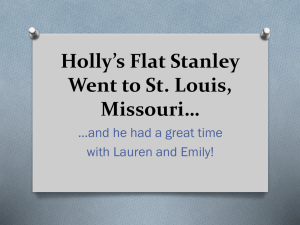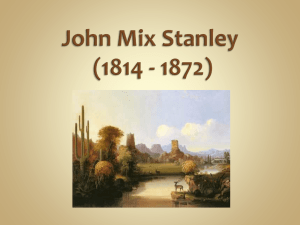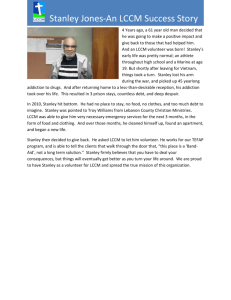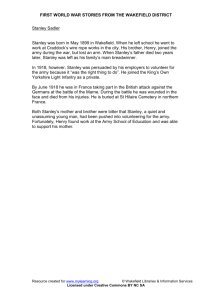BMC 1 - John STANLEY (1712-1786): Six Concertos Op 2
advertisement
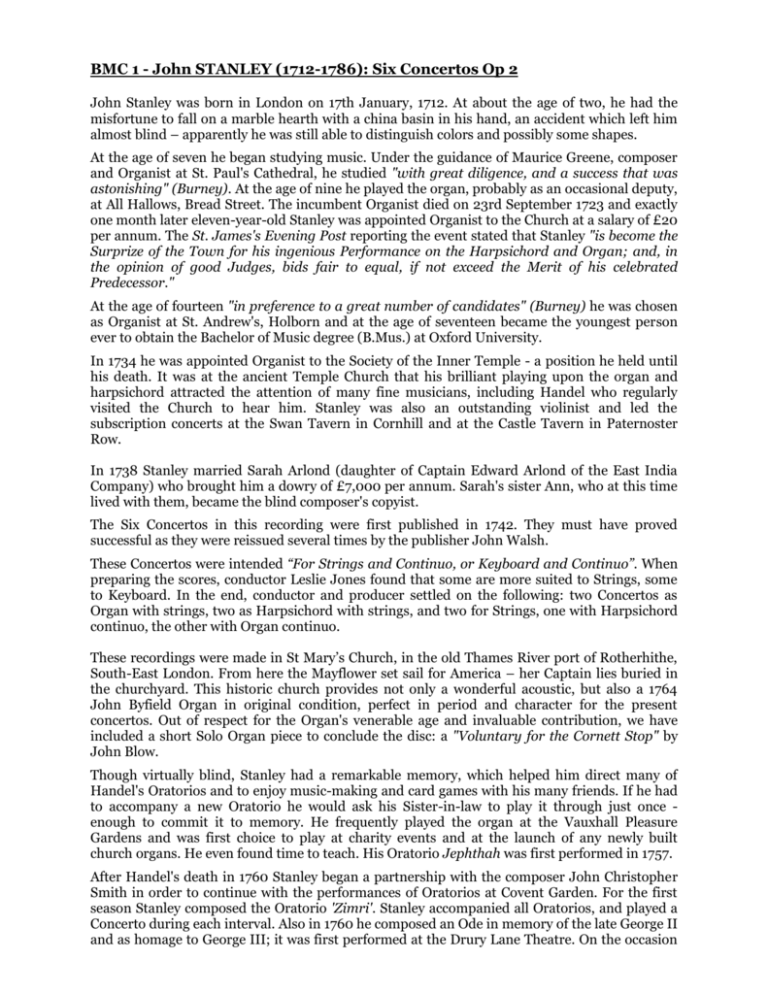
BMC 1 - John STANLEY (1712-1786): Six Concertos Op 2 John Stanley was born in London on 17th January, 1712. At about the age of two, he had the misfortune to fall on a marble hearth with a china basin in his hand, an accident which left him almost blind – apparently he was still able to distinguish colors and possibly some shapes. At the age of seven he began studying music. Under the guidance of Maurice Greene, composer and Organist at St. Paul's Cathedral, he studied "with great diligence, and a success that was astonishing" (Burney). At the age of nine he played the organ, probably as an occasional deputy, at All Hallows, Bread Street. The incumbent Organist died on 23rd September 1723 and exactly one month later eleven-year-old Stanley was appointed Organist to the Church at a salary of £20 per annum. The St. James's Evening Post reporting the event stated that Stanley "is become the Surprize of the Town for his ingenious Performance on the Harpsichord and Organ; and, in the opinion of good Judges, bids fair to equal, if not exceed the Merit of his celebrated Predecessor." At the age of fourteen "in preference to a great number of candidates" (Burney) he was chosen as Organist at St. Andrew's, Holborn and at the age of seventeen became the youngest person ever to obtain the Bachelor of Music degree (B.Mus.) at Oxford University. In 1734 he was appointed Organist to the Society of the Inner Temple - a position he held until his death. It was at the ancient Temple Church that his brilliant playing upon the organ and harpsichord attracted the attention of many fine musicians, including Handel who regularly visited the Church to hear him. Stanley was also an outstanding violinist and led the subscription concerts at the Swan Tavern in Cornhill and at the Castle Tavern in Paternoster Row. In 1738 Stanley married Sarah Arlond (daughter of Captain Edward Arlond of the East India Company) who brought him a dowry of £7,000 per annum. Sarah's sister Ann, who at this time lived with them, became the blind composer's copyist. The Six Concertos in this recording were first published in 1742. They must have proved successful as they were reissued several times by the publisher John Walsh. These Concertos were intended “For Strings and Continuo, or Keyboard and Continuo”. When preparing the scores, conductor Leslie Jones found that some are more suited to Strings, some to Keyboard. In the end, conductor and producer settled on the following: two Concertos as Organ with strings, two as Harpsichord with strings, and two for Strings, one with Harpsichord continuo, the other with Organ continuo. These recordings were made in St Mary’s Church, in the old Thames River port of Rotherhithe, South-East London. From here the Mayflower set sail for America – her Captain lies buried in the churchyard. This historic church provides not only a wonderful acoustic, but also a 1764 John Byfield Organ in original condition, perfect in period and character for the present concertos. Out of respect for the Organ's venerable age and invaluable contribution, we have included a short Solo Organ piece to conclude the disc: a "Voluntary for the Cornett Stop" by John Blow. Though virtually blind, Stanley had a remarkable memory, which helped him direct many of Handel's Oratorios and to enjoy music-making and card games with his many friends. If he had to accompany a new Oratorio he would ask his Sister-in-law to play it through just once enough to commit it to memory. He frequently played the organ at the Vauxhall Pleasure Gardens and was first choice to play at charity events and at the launch of any newly built church organs. He even found time to teach. His Oratorio Jephthah was first performed in 1757. After Handel's death in 1760 Stanley began a partnership with the composer John Christopher Smith in order to continue with the performances of Oratorios at Covent Garden. For the first season Stanley composed the Oratorio 'Zimri'. Stanley accompanied all Oratorios, and played a Concerto during each interval. Also in 1760 he composed an Ode in memory of the late George II and as homage to George III; it was first performed at the Drury Lane Theatre. On the occasion of the King's wedding in 1762 he composed a dramatic pastoral Oratorio, Arcadia. Handel had been a Governor of the Foundling Hospital, London. The Hospital’s Chapel Organ was Handel’s gift, and Handel himself directed eleven performances of the Messiah there, so raising 7,000 Pounds for the charity. Continuing yet again in Handel's footsteps, Stanley was elected a governor of the same Hospital in 1770, and from 1775 until 1777 he directed the annual performance of Handel's Messiah in aid of the Hospital funds. In 1779 Stanley succeeded William Boyce as Master of the King's Band of Musicians. In this capacity he composed many New Year and Birthday Odes to the King but unfortunately this music has not survived. Stanley's last work was probably an Ode written for the King's Birthday (4th June 1786). Stanley never heard its performance - he died at his home in Hatton Garden on 19th May, 1786, aged 74. Roger Slade __________________________________________________________________ ___________________ Recorded December 1969 by Oryx Sound Studios at St. Mary’s, Rotherhithe. Harold Lester’s harpsichord was built by Hugh Gough. Front cover: Giovanni Antonio Canal (Canaletto) 1697-1768: Westminster Bridge, London, with the Lord Mayor's Procession on the Thames, 1747. Oil on canvas. The Historic JOHN BYFIELD Organ of 1764, St. Mary's Church, Rotherhithe, London. The Thames-side port of Rotherhithe, South East London, is a down-to-earth, functional place, with a beauty and fascination of its own. Its links with the sea are ancient; the Mayflower sailed from Rotherhithe, her Captain lies buried in the churchyard. The present church dates from 1714. Situated on a slight rise not far from the Thames River, it is surrounded by narrow twisting streets, warehouses, a flour mill, and mature trees. Inside the church other trees form the unseen oaken cores of the four large columns that support the barrel-vaulted ceiling. The West Gallery is supported on wrought-iron stanchions with ornamental heads; here stands the organ, built by John Byfield and "Erected by Subscription of some of the Inhabitants of the Parish A.D. 1764". The imposing case is characteristic of the period in its basic design of two flats and three heavilycorniced towers; it is of mahogany, richly decorated with carved and pierced gilt woodwork, and the show-pipes form part of the original Open Diapason rank. A Swell Organ was added during the 19th century, but it is interesting to note that "all the best sounds" are original, and in fact only the 1764 stops on the two lower manuals are used in our recording. The 1764 specification is as follows. GREAT Cornet V Trumpet 8 Sesquialtera III 15th 2 12th 3 Principal 4 Clarion 4 Stopped Diapason 8 Open Diapason (left) 8 Open Diapason (right) 8 CHOIR Cremona 8 15th 2 Flute 4 Principal 4 Stopped Diapason PEDAL Grand Bourdon Couplers 8 16 G/P C/P


